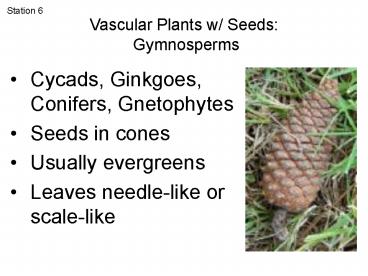Vascular Plants w Seeds: Gymnosperms PowerPoint PPT Presentation
1 / 13
Title: Vascular Plants w Seeds: Gymnosperms
1
Station 6
Vascular Plants w/ Seeds Gymnosperms
- Cycads, Ginkgoes, Conifers, Gnetophytes
- Seeds in cones
- Usually evergreens
- Leaves needle-like or scale-like
2
Station 6
4 Types of Gymnosperms
- Phylum Ginkgophyta
- Gingko
- Leaves fan-shaped
- Only one species
- Ancient group
- Phylum Coniferophyta
- Cone Bearers
- Pine Trees
- Phylum Cycadophyta
- Cycads
- palm-like ancient group (not palms)
- Phylum Gnetophyta
- Assumed to be the closest related to flowering
plants - Ex Ephedra
3
Station 6
ALTERNATION OF GENERATIONS
4
Station 7
Today's most successful plants are Angiosperms
5
Station 7
Angiosperm (Phylum Anthophyta)
- Mature seeds are enclosed in fruits
- Most species of plants
- Flowers are reproductive structures
- Male stamen
- Female carpel or pistil
6
Station 7
ALTERNATION OF GENERATIONS
7
Station 8
Identify each of the following plants as either
monocots or dicots
B
C
D
E
A
I
F
G
H
8
Station 8
9
Station 8
10
Station 8
Cotyledons Structure in the embryo of a seed
plant that may form a leaf after germination
and is commonly known as a seed leaf. It is not a
true foliage leaf. It fills most of the seed's
volume. In a monocot, there is only one. In a
dicot, there are two cotyledons visible...seed
opens into 2 halves. Epicotyl The first shoot
that emerges. The epicotyl in this picture has
macroscopic leaves visible. Hypocotyl The
hypocotyl is the primary organ of extension of
the young plant and develops into the stem. It
is the region of the stem BELOW the
Cotyledons. Radicle The primary root of a plant,
developed in a seedling the embryonic root of a
seedling
Radicle
CS
Cotyledon scar
H
Hypocotyl
11
Station 9
Plant Lifespan
- Annual - flowering plant that completes a life
cycle within one growing season - Biennial - flowering plant that completes its
life cycle in two years - Perennial - flowering plant that lives for more
than two years
12
Station 9
Pollination, fertilization, germination, and
dormancy
- Pollination To transfer pollen from an anther
to the stigma of (a flower) - Fertilization The union of male and female
gametes to form a zygote - Germination - early growth stage of a plant
embryo - Dormancy - period of time during which a plant
embryo is alive but not growing
13
Station 9
Pollinators (http//pollinators.nbii.gov/portal/s
erver.pt) Imagine living in a world without bees
or other pollinators! It would be a world without
flowers, fruit, even a cup of coffee. A world,
even, without chocolate! Thanks to the wonderful
work of bees, butterflies, birds, and
other animal pollinators, the world's flowering
plants are able to reproduce and bear fruit,
providing many of the foods we eat, the plant
materials we and other organisms use, and the
beauty we see around us. Yet today, there is
evidence indicating alarming pollinator
population declines worldwide. Domesticated
honeybees are not the only pollinators in trouble
these days. Many species of butterflies, moths,
birds, bats and other pollinators are also in
retreat, threatening not only the production of
commercial crops but also a wide range of
flowering plants, including rare and endangered
species. "Action must be taken to reverse these
trends," says Stephen Buchmann, an entomologist
at the U.S. Department of Agriculture's Carl
Hayden Bee Research Center in Tucson, Arizona.
According to Buchmann, only a few of these
pollinators (mainly Hawaiian bird species) are
protected by the Federal Endangered Species Act.
"This is simply because the world is focused on
the charismatic megafauna--the lions and tigers
and bears," he says. "The little things that run
the world, including bees, butterflies, bats and
hummingbirds, go unnoticed and unprotected until
it is sometimes too late."

